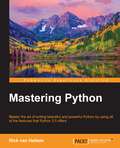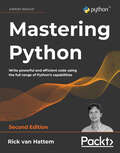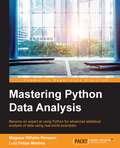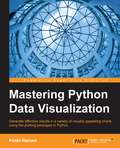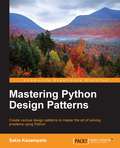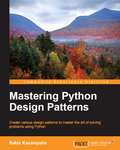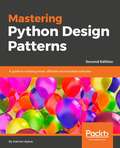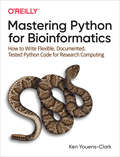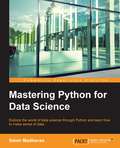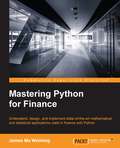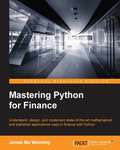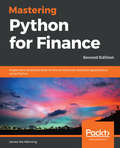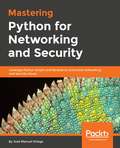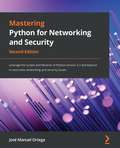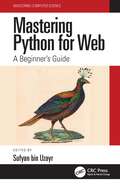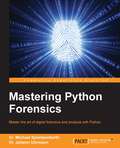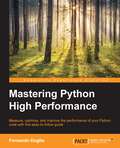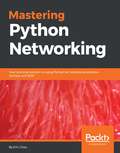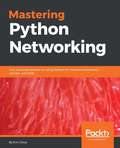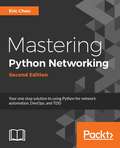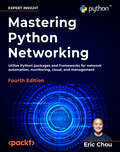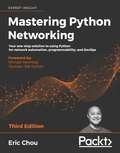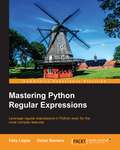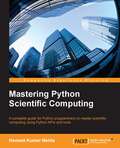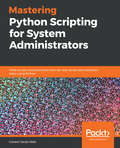- Table View
- List View
Mastering Python
by Rick Van HattemMaster the art of writing beautiful and powerful Python by using all of the features that Python 3.5 offers About This Book * Become familiar with the most important and advanced parts of the Python code style * Learn the trickier aspects of Python and put it in a structured context for deeper understanding of the language * Offers an expert's-eye overview of how these advanced tasks fit together in Python as a whole along with practical examples Who This Book Is For Almost anyone can learn to write working script and create high quality code but they might lack a structured understanding of what it means to be 'Pythonic'. If you are a Python programmer who wants to code efficiently by getting the syntax and usage of a few intricate Python techniques exactly right, this book is for you. What You Will Learn * Create a virtualenv and start a new project * Understand how and when to use the functional programming paradigm * Get familiar with the different ways the decorators can be written in * Understand the power of generators and coroutines without digressing into lambda calculus * Create metaclasses and how it makes working with Python far easier * Generate HTML documentation out of documents and code using Sphinx * Learn how to track and optimize application performance, both memory and cpu * Use the multiprocessing library, not just locally but also across multiple machines * Get a basic understanding of packaging and creating your own libraries/applications In Detail Python is a dynamic programming language. It is known for its high readability and hence it is often the first language learned by new programmers. Python being multi-paradigm, it can be used to achieve the same thing in different ways and it is compatible across different platforms. Even if you find writing Python code easy, writing code that is efficient, easy to maintain, and reuse is not so straightforward. This book is an authoritative guide that will help you learn new advanced methods in a clear and contextualised way. It starts off by creating a project-specific environment using venv, introducing you to different Pythonic syntax and common pitfalls before moving on to cover the functional features in Python. It covers how to create different decorators, generators, and metaclasses. It also introduces you to functools.wraps and coroutines and how they work. Later on you will learn to use asyncio module for asynchronous clients and servers. You will also get familiar with different testing systems such as py.test, doctest, and unittest, and debugging tools such as Python debugger and faulthandler. You will learn to optimize application performance so that it works efficiently across multiple machines and Python versions. Finally, it will teach you how to access C functions with a simple Python call. By the end of the book, you will be able to write more advanced scripts and take on bigger challenges. Style and Approach This book is a comprehensive guide that covers advanced features of the Python language, and communicate them with an authoritative understanding of the underlying rationale for how, when, and why to use them.
Mastering Python: Write powerful and efficient code using the full range of Python's capabilities, 2nd Edition
by Rick van HattemUse advanced features of Python to write high-quality, readable code and packagesKey FeaturesExtensively updated for Python 3.10 with new chapters on design patterns, scientific programming, machine learning, and interactive PythonShape your scripts using key concepts like concurrency, performance optimization, asyncio, and multiprocessingLearn how advanced Python features fit together to produce maintainable codeBook DescriptionEven if you find writing Python code easy, writing code that is efficient, maintainable, and reusable is not so straightforward. Many of Python's capabilities are underutilized even by more experienced programmers. Mastering Python, Second Edition, is an authoritative guide to understanding advanced Python programming so you can write the highest quality code. This new edition has been extensively revised and updated with exercises, four new chapters and updates up to Python 3.10.Revisit important basics, including Pythonic style and syntax and functional programming. Avoid common mistakes made by programmers of all experience levels. Make smart decisions about the best testing and debugging tools to use, optimize your code's performance across multiple machines and Python versions, and deploy often-forgotten Python features to your advantage. Get fully up to speed with asyncio and stretch the language even further by accessing C functions with simple Python calls. Finally, turn your new-and-improved code into packages and share them with the wider Python community.If you are a Python programmer wanting to improve your code quality and readability, this Python book will make you confident in writing high-quality scripts and taking on bigger challengesWhat you will learnWrite beautiful Pythonic code and avoid common Python coding mistakesApply the power of decorators, generators, coroutines, and metaclassesUse different testing systems like pytest, unittest, and doctestTrack and optimize application performance for both memory and CPU usageDebug your applications with PDB, Werkzeug, and faulthandlerImprove your performance through asyncio, multiprocessing, and distributed computingExplore popular libraries like Dask, NumPy, SciPy, pandas, TensorFlow, and scikit-learnExtend Python's capabilities with C/C++ libraries and system callsWho this book is forThis book will benefit more experienced Python programmers who wish to upskill, serving as a reference for best practices and some of the more intricate Python techniques. Even if you have been using Python for years, chances are that you haven't yet encountered every topic discussed in this book. A good understanding of Python programming is necessary
Mastering Python Data Analysis
by Magnus Vilhelm Persson Luiz Felipe MartinsBecome an expert at using Python for advanced statistical analysis of data using real-world examples About This Book * Clean, format, and explore data using graphical and numerical summaries * Leverage the IPython environment to efficiently analyze data with Python * Packed with easy-to-follow examples to develop advanced computational skills for the analysis of complex data Who This Book Is For If you are a competent Python developer who wants to take your data analysis skills to the next level by solving complex problems, then this advanced guide is for you. Familiarity with the basics of applying Python libraries to data sets is assumed. What You Will Learn * Read, sort, and map various data into Python and Pandas * Recognise patterns so you can understand and explore data * Use statistical models to discover patterns in data * Review classical statistical inference using Python, Pandas, and SciPy * Detect similarities and differences in data with clustering * Clean your data to make it useful * Work in Jupyter Notebook to produce publication ready figures to be included in reports In Detail Python, a multi-paradigm programming language, has become the language of choice for data scientists for data analysis, visualization, and machine learning. Ever imagined how to become an expert at effectively approaching data analysis problems, solving them, and extracting all of the available information from your data? Well, look no further, this is the book you want! Through this comprehensive guide, you will explore data and present results and conclusions from statistical analysis in a meaningful way. You'll be able to quickly and accurately perform the hands-on sorting, reduction, and subsequent analysis, and fully appreciate how data analysis methods can support business decision-making. You'll start off by learning about the tools available for data analysis in Python and will then explore the statistical models that are used to identify patterns in data. Gradually, you'll move on to review statistical inference using Python, Pandas, and SciPy. After that, we'll focus on performing regression using computational tools and you'll get to understand the problem of identifying clusters in data in an algorithmic way. Finally, we delve into advanced techniques to quantify cause and effect using Bayesian methods and you'll discover how to use Python's tools for supervised machine learning. Style and approach This book takes a step-by-step approach to reading, processing, and analyzing data in Python using various methods and tools. Rich in examples, each topic connects to real-world examples and retrieves data directly online where possible. With this book, you are given the knowledge and tools to explore any data on your own, encouraging a curiosity befitting all data scientists.
Mastering Python Data Visualization
by Kirthi RamanGenerate effective results in a variety of visually appealing charts using the plotting packages in PythonAbout This BookExplore various tools and their strengths while building meaningful representations that can make it easier to understand dataPacked with computational methods and algorithms in diverse fields of scienceWritten in an easy-to-follow categorical style, this book discusses some niche techniques that will make your code easier to work with and reuseWho This Book Is ForIf you are a Python developer who performs data visualization and wants to develop existing knowledge about Python to build analytical results and produce some amazing visual display, then this book is for you. A basic knowledge level and understanding of Python libraries is assumed.What You Will LearnGather, cleanse, access, and map data to a visual frameworkRecognize which visualization method is applicable and learn best practices for data visualizationGet acquainted with reader-driven narratives and author-driven narratives and the principles of perceptionUnderstand why Python is an effective tool to be used for numerical computation much like MATLAB, and explore some interesting data structures that come with itExplore with various visualization choices how Python can be very useful in computation in the field of finance and statisticsGet to know why Python is the second choice after Java, and is used frequently in the field of machine learningCompare Python with other visualization approaches using Julia and a JavaScript-based framework such as D3.jsDiscover how Python can be used in conjunction with NoSQL such as Hive to produce results efficiently in a distributed environmentIn DetailPython has a handful of open source libraries for numerical computations involving optimization, linear algebra, integration, interpolation, and other special functions using array objects, machine learning, data mining, and plotting. Pandas have a productive environment for data analysis. These libraries have a specific purpose and play an important role in the research into diverse domains including economics, finance, biological sciences, social science, health care, and many more. The variety of tools and approaches available within Python community is stunning, and can bolster and enhance visual story experiences.This book offers practical guidance to help you on the journey to effective data visualization. Commencing with a chapter on the data framework, which explains the transformation of data into information and eventually knowledge, this book subsequently covers the complete visualization process using the most popular Python libraries with working examples. You will learn the usage of Numpy, Scipy, IPython, MatPlotLib, Pandas, Patsy, and Scikit-Learn with a focus on generating results that can be visualized in many different ways. Further chapters are aimed at not only showing advanced techniques such as interactive plotting; numerical, graphical linear, and non-linear regression; clustering and classification, but also in helping you understand the aesthetics and best practices of data visualization. The book concludes with interesting examples such as social networks, directed graph examples in real-life, data structures appropriate for these problems, and network analysis.By the end of this book, you will be able to effectively solve a broad set of data analysis problems.Style and approachThe approach of this book is not step by step, but rather categorical. The categories are based on fields such as bioinformatics, statistical and machine learning, financial computation, and linear algebra. This approach is beneficial for the community in many different fields of work and also helps you learn how one approach can make sense across many fields
Mastering Python Design Patterns
by Sakis KasampalisThis book is for Python programmers with an intermediate background and an interest in design patterns implemented in idiomatic Python. Programmers of other languages who are interested in Python can also benefit from this book, but it would be better if they first read some introductory materials that explain how things are done in Python.
Mastering Python Design Patterns
by Sakis Kasampalis<P><P>Create various design patterns to master the art of solving problems using Python <P><P>About This Book <P><P>Simplify design pattern implementation using the power of Python <P><P>Each pattern is accompanied with a real-world example demonstrating its key features <P><P>This is an easy-to-follow guide focusing on the practical aspects of Python design patterns <P><P>Who This Book Is For <P><P>This book is for Python programmers with an intermediate background and an interest in design patterns implemented in idiomatic Python. Programmers of other languages who are interested in Python can also benefit from this book, but it would be better if they first read some introductory materials that explain how things are done in Python. <P><P>What You Will Learn <P><P>Explore Factory Method and Abstract Factory for object creation <P><P>Clone objects using the Prototype pattern <P><P>Make incompatible interfaces compatible using the Adapter pattern <P><P>Secure an interface using the Proxy pattern <P><P>Choose an algorithm dynamically using the Strategy pattern <P><P>Extend an object without subclassing using the Decorator pattern <P><P>Keep the logic decoupled from the UI using the MVC pattern <P><P>In Detail <P><P>Python is an object-oriented, scripting language that is used in wide range of categories. In software engineering, a design pattern is a recommended solution to a software design problem. Although not new, design patterns remain one of the hottest topics in software engineering and they come as a ready reference for software developers to solve the common problems they face at work. <P><P>This book will take you through each and every design pattern explained with the help of real-world examples. The aim of the book is to introduce more low-level detail and concepts on how to write Pythonic code, not just focusing on common solutions as implemented in Java and C++. It includes small sections on troubleshooting, best practices, system architecture, and its design aspects. With the help of this book, you will be able to understand Python design pattern concepts and the framework, as well as issues and their resolution. You'll focus on all 16 design patterns that are used to solve everyday problems.
Mastering Python Design Patterns: A guide to creating smart, efficient, and reusable software, 2nd Edition
by Sakis Kasampalis Kamon AyevaExploit various design patterns to master the art of solving problems using PythonKey FeaturesMaster the application design using the core design patterns and latest features of Python 3.7Learn tricks to solve common design and architectural challengesChoose the right plan to improve your programs and increase their productivityBook DescriptionPython is an object-oriented scripting language that is used in a wide range of categories. In software engineering, a design pattern is an elected solution for solving software design problems. Although they have been around for a while, design patterns remain one of the top topics in software engineering, and are a ready source for software developers to solve the problems they face on a regular basis. This book takes you through a variety of design patterns and explains them with real-world examples. You will get to grips with low-level details and concepts that show you how to write Python code, without focusing on common solutions as enabled in Java and C++. You'll also fnd sections on corrections, best practices, system architecture, and its designing aspects. This book will help you learn the core concepts of design patterns and the way they can be used to resolve software design problems. You'll focus on most of the Gang of Four (GoF) design patterns, which are used to solve everyday problems, and take your skills to the next level with reactive and functional patterns that help you build resilient, scalable, and robust applications. By the end of the book, you'll be able to effciently address commonly faced problems and develop applications, and also be comfortable working on scalable and maintainable projects of any size.What you will learnExplore Factory Method and Abstract Factory for object creationClone objects using the Prototype patternMake incompatible interfaces compatible using the Adapter patternSecure an interface using the Proxy patternChoose an algorithm dynamically using the Strategy patternKeep the logic decoupled from the UI using the MVC patternLeverage the Observer pattern to understand reactive programmingExplore patterns for cloud-native, microservices, and serverless architecturesWho this book is forThis book is for intermediate Python developers. Prior knowledge of design patterns is not required to enjoy this book.
Mastering Python for Bioinformatics: How To Write Flexible, Documented, Tested Python Code For Research Computing
by Ken Youens-ClarkLife scientists today urgently need training in bioinformatics skills. Too many bioinformatics programs are poorly written and barely maintained--usually by students and researchers who've never learned basic programming skills. This practical guide shows postdoc bioinformatics professionals and students how to exploit the best parts of Python to solve problems in biology while creating documented, tested, reproducible software.Ken Youens-Clark, author of Tiny Python Projects (Manning), demonstrates not only how to write effective Python code but also how to use tests to write and refactor scientific programs. You'll learn the latest Python features and toolsâ??including linters, formatters, type checkers, and testsâ??to create documented and tested programs. You'll also tackle 14 challenges in Rosalind, a problem-solving platform for learning bioinformatics and programming.Create command-line Python programs to document and validate parametersWrite tests to verify refactor programs and confirm they're correctAddress bioinformatics ideas using Python data structures and modules such as BiopythonCreate reproducible shortcuts and workflows using makefilesParse essential bioinformatics file formats such as FASTA and FASTQFind patterns of text using regular expressionsUse higher-order functions in Python like filter(), map(), and reduce()
Mastering Python for Data Science
by Samir MadhavanExplore the world of data science through Python and learn how to make sense of data About This Book * Master data science methods using Python and its libraries * Create data visualizations and mine for patterns * Advanced techniques for the four fundamentals of Data Science with Python - data mining, data analysis, data visualization, and machine learning Who This Book Is For If you are a Python developer who wants to master the world of data science then this book is for you. Some knowledge of data science is assumed. What You Will Learn * Manage data and perform linear algebra in Python * Derive inferences from the analysis by performing inferential statistics * Solve data science problems in Python * Create high-end visualizations using Python * Evaluate and apply the linear regression technique to estimate the relationships among variables. * Build recommendation engines with the various collaborative filtering algorithms * Apply the ensemble methods to improve your predictions * Work with big data technologies to handle data at scale In Detail Data science is a relatively new knowledge domain which is used by various organizations to make data driven decisions. Data scientists have to wear various hats to work with data and to derive value from it. The Python programming language, beyond having conquered the scientific community in the last decade, is now an indispensable tool for the data science practitioner and a must-know tool for every aspiring data scientist. Using Python will offer you a fast, reliable, cross-platform, and mature environment for data analysis, machine learning, and algorithmic problem solving. This comprehensive guide helps you move beyond the hype and transcend the theory by providing you with a hands-on, advanced study of data science. Beginning with the essentials of Python in data science, you will learn to manage data and perform linear algebra in Python. You will move on to deriving inferences from the analysis by performing inferential statistics, and mining data to reveal hidden patterns and trends. You will use the matplot library to create high-end visualizations in Python and uncover the fundamentals of machine learning. Next, you will apply the linear regression technique and also learn to apply the logistic regression technique to your applications, before creating recommendation engines with various collaborative filtering algorithms and improving your predictions by applying the ensemble methods. Finally, you will perform K-means clustering, along with an analysis of unstructured data with different text mining techniques and leveraging the power of Python in big data analytics. Style and approach This book is an easy-to-follow, comprehensive guide on data science using Python. The topics covered in the book can all be used in real world scenarios.
Mastering Python for Finance
by James Ma WeimingIf you are an undergraduate or graduate student, a beginner to algorithmic development and research, or a software developer in the financial industry who is interested in using Python for quantitative methods in finance, this is the book for you. It would be helpful to have a bit of familiarity with basic Python usage, but no prior experience is required.
Mastering Python for Finance
by James Ma Weiming<P><P>Understand, design, and implement state-of-the-art mathematical and statistical applications used in finance with Python <P><P>About This Book <P><P>Explore financial models used by the industry and ways of solving them with this guide <P><P>Discover the various features that Python provides for scientific computing and harness them to enhance your financial applications <P><P>Build state-of-the-art infrastructure for critical aspects such as modeling, trading, pricing, and analytics <P><P>Who This Book Is For <P><P>If you are an undergraduate or graduate student, a beginner to algorithmic development and research, or a software developer in the financial industry who is interested in using Python for quantitative methods in finance, this is the book for you. It would be helpful to have a bit of familiarity with basic Python usage, but no prior experience is required. <P><P>What You Will Learn <P><P>Perform interactive computing with IPython Notebook <P><P>Solve linear equations of financial models and perform ordinary least squares regression <P><P>Explore nonlinear modeling and solutions for optimum points using root-finding algorithms and solvers <P><P>Discover different types of numerical procedures used in pricing options <P><P>Model fixed-income instruments with bonds and interest rates <P><P>Manage big data with NoSQL and perform analytics with Hadoop <P><P>Build a high-frequency algorithmic trading platform with Python <P><P>Create an event-driven backtesting tool and measure your strategies <P><P>In Detail <P><P>Built initially for scientific computing, Python quickly found its place in finance. Its flexibility and robustness can be easily incorporated into applications for mathematical studies, research, and software development. <P><P>With this book, you will learn about all the tools you need to successfully perform research studies and modeling, improve your trading strategies, and effectively manage risks. You will explore the various tools and techniques used in solving complex problems commonly faced in finance. <P><P>You will learn how to price financial instruments such as stocks, options, interest rate derivatives, and futures using computational methods. Also, you will learn how you can perform data analytics on market indexes and use NoSQL to store tick data.
Mastering Python for Finance: Implement advanced state-of-the-art financial statistical applications using Python, 2nd Edition
by James Ma WeimingTake your financial skills to the next level by mastering cutting-edge mathematical and statistical financial applicationsKey FeaturesExplore advanced financial models used by the industry and ways of solving them using PythonBuild state-of-the-art infrastructure for modeling, visualization, trading, and moreEmpower your financial applications by applying machine learning and deep learningBook DescriptionThe second edition of Mastering Python for Finance will guide you through carrying out complex financial calculations practiced in the industry of finance by using next-generation methodologies. You will master the Python ecosystem by leveraging publicly available tools to successfully perform research studies and modeling, and learn to manage risks with the help of advanced examples.You will start by setting up your Jupyter notebook to implement the tasks throughout the book. You will learn to make efficient and powerful data-driven financial decisions using popular libraries such as TensorFlow, Keras, Numpy, SciPy, and sklearn. You will also learn how to build financial applications by mastering concepts such as stocks, options, interest rates and their derivatives, and risk analytics using computational methods. With these foundations, you will learn to apply statistical analysis to time series data, and understand how time series data is useful for implementing an event-driven backtesting system and for working with high-frequency data in building an algorithmic trading platform. Finally, you will explore machine learning and deep learning techniques that are applied in finance.By the end of this book, you will be able to apply Python to different paradigms in the financial industry and perform efficient data analysis.What you will learnSolve linear and nonlinear models representing various financial problemsPerform principal component analysis on the DOW index and its componentsAnalyze, predict, and forecast stationary and non-stationary time series processesCreate an event-driven backtesting tool and measure your strategiesBuild a high-frequency algorithmic trading platform with PythonReplicate the CBOT VIX index with SPX options for studying VIX-based strategiesPerform regression-based and classification-based machine learning tasks for predictionUse TensorFlow and Keras in deep learning neural network architectureWho this book is forIf you are a financial or data analyst or a software developer in the financial industry who is interested in using advanced Python techniques for quantitative methods in finance, this is the book you need! You will also find this book useful if you want to extend the functionalities of your existing financial applications by using smart machine learning techniques. Prior experience in Python is required.
Mastering Python for Networking and Security: Leverage Python scripts and libraries to overcome networking and security issues
by José Manuel OrtegaMaster Python scripting to build a network and perform security operationsKey FeaturesLearn to handle cyber attacks with modern Python scriptingDiscover various Python libraries for building and securing your networkUnderstand Python packages and libraries to secure your network infrastructureBook DescriptionIt’s becoming more and more apparent that security is a critical aspect of IT infrastructure. A data breach is a major security incident, usually carried out by just hacking a simple network line. Increasing your network’s security helps step up your defenses against cyber attacks. Meanwhile, Python is being used for increasingly advanced tasks, with the latest update introducing many new packages. This book focuses on leveraging these updated packages to build a secure network with the help of Python scripting. This book covers topics from building a network to the different procedures you need to follow to secure it. You’ll first be introduced to different packages and libraries, before moving on to different ways to build a network with the help of Python scripting. Later, you will learn how to check a network’s vulnerability using Python security scripting, and understand how to check vulnerabilities in your network. As you progress through the chapters, you will also learn how to achieve endpoint protection by leveraging Python packages along with writing forensic scripts. By the end of this book, you will be able to get the most out of the Python language to build secure and robust networks that are resilient to attacks.What you will learnDevelop Python scripts for automating security and pentesting tasksDiscover the Python standard library's main modules used for performing security-related tasksAutomate analytical tasks and the extraction of information from serversExplore processes for detecting and exploiting vulnerabilities in serversUse network software for Python programmingPerform server scripting and port scanning with PythonIdentify vulnerabilities in web applications with PythonUse Python to extract metadata and forensicsWho this book is forThis book is ideal for network engineers, system administrators, or any security professional looking at tackling networking and security challenges. Programmers with some prior experience in Python will get the most out of this book. Some basic understanding of general programming structures and Python is required.
Mastering Python for Networking and Security - Second Edition
by José Manuel OrtegaThis Python network security book is for network engineers, system administrators, or any security professional looking to overcome networking and security challenges. You will also find this book useful if you’re a programmer with prior experience in Python. A basic understanding of general programming structures and the Python programming language is required before getting started.
Mastering Python for Web: A Beginner's Guide (Mastering Computer Science)
by Sufyan Bin UzayrPython for Web Python definitely tops the charts when it comes to ease of use and beginner-friendly learning curve in the world of programming languages. At the same time, Python is essential when it comes to writing system scripts, processing big data, performing mathematical computations, creating web applications, and rapid prototyping. With this Mastering edition, we have focused especially on the usage of Python for Web. This book explores Python programming fundamentals with interactive projects and introduces core coding concepts and the basics of Python-based web development. The reader should be ready to dive deep into the world of Python for web development in no time. Since Python positions itself in web development as a back-end language, it is usually mixed with another front-end language to build a whole website. At the same time, reasons for using Python in web development are many: it is a flexible, versatile, and highly efficient programming language with dynamic typing capacity. This book helps readers to examine Python’s key back-end/front-end programming techniques and guides them through implementing them when creating professional projects. Furthermore, it also focuses on teaching readers how to solve common problems and developing web services with Python frameworks such as Django and Flask. Mastering Python for Web has a goal more ambitious than simply teaching you the ropes – it aims to help you embrace and master problem solving, which could be viewed as the single most crucial skill for a coder. It offers you a focal point on starting as a beginner and growing into an expert by putting your newly acquired knowledge into practice. Programming is a hands-on skill, and this particular book helps you put your skills to test with easy-to-grasp tasks and examples. Learn more about our other Mastering titles at: https://www.routledge.com/Mastering-Computer-Science/book-series/MCS
Mastering Python Forensics
by Dr Michael SpreitzenbarthIf you are a network security professional or forensics analyst who wants to gain a deeper understanding of performing forensic analysis with Python, then this book is for you. Some Python experience would be helpful.
Mastering Python High Performance
by Fernando DoglioMeasure, optimize, and improve the performance of your Python code with this easy-to-follow guide About This Book * Master the do's and don'ts of Python performance programming * Learn how to use exiting new tools that will help you improve your scripts * A step-by-step, conceptual guide to teach you how to optimize and fine-tune your critical pieces of code Who This Book Is For If you're a Python developer looking to improve the speed of your scripts or simply wanting to take your skills to the next level, then this book is perfect for you. What You Will Learn * Master code optimization step-by-step and learn how to use different tools * Understand what a profiler is and how to read its output * Interpret visual output from profiling tools and improve the performance of your script * Use Cython to create fast applications using Python and C * Take advantage of PyPy to improve performance of Python code * Optimize number-crunching code with NumPy, Numba, Parakeet, and Pandas In Detail Simply knowing how to code is not enough; on mission-critical pieces of code, every bit of memory and every CPU cycle counts, and knowing how to squish every bit of processing power out of your code is a crucial and sought-after skill. Nowadays, Python is used for many scientific projects, and sometimes the calculations done in those projects require some serious fine-tuning. Profilers are tools designed to help you measure the performance of your code and help you during the optimization process, so knowing how to use them and read their output is very handy. This book starts from the basics and progressively moves on to more advanced topics. You'll learn everything from profiling all the way up to writing a real-life application and applying a full set of tools designed to improve it in different ways. In the middle, you'll stop to learn about the major profilers used in Python and about some graphic tools to help you make sense of their output. You'll then move from generic optimization techniques onto Python-specific ones, going over the main constructs of the language that will help you improve your speed without much of a change. Finally, the book covers some number-crunching-specific libraries and how to use them properly to get the best speed out of them. After reading this book, you will know how to take any Python code, profile it, find out where the bottlenecks are, and apply different techniques to remove them. Style and approach This easy-to-follow, practical guide will help you enhance your optimization skills by improving real-world code.
Mastering Python Networking
by Eric ChouBecome an expert in implementing advanced, network-related tasks with Python. About This Book • Build the skills to perform all networking tasks using Python with ease • Use Python for network device automation, DevOps, and software-defined networking • Get practical guidance to networking with Python Who This Book Is For If you are a network engineer or a programmer who wants to use Python for networking, then this book is for you. A basic familiarity with networking-related concepts such as TCP/IP and a familiarity with Python programming will be useful. What You Will Learn • Review all the fundamentals of Python and the TCP/IP suite • Use Python to execute commands when the device does not support the API or programmatic interaction with the device • Implement automation techniques by integrating Python with Cisco, Juniper, and Arista eAPI • Integrate Ansible using Python to control Cisco, Juniper, and Arista networks • Achieve network security with Python • Build Flask-based web-service APIs with Python • Construct a Python-based migration plan from a legacy to scalable SDN-based network. In Detail This book begins with a review of the TCP/ IP protocol suite and a refresher of the core elements of the Python language. Next, you will start using Python and supported libraries to automate network tasks from the current major network vendors. We will look at automating traditional network devices based on the command-line interface, as well as newer devices with API support, with hands-on labs. We will then learn the concepts and practical use cases of the Ansible framework in order to achieve your network goals. We will then move on to using Python for DevOps, starting with using open source tools to test, secure, and analyze your network. Then, we will focus on network monitoring and visualization. We will learn how to retrieve network information using a polling mechanism, ?ow-based monitoring, and visualizing the data programmatically. Next, we will learn how to use the Python framework to build your own customized network web services. In the last module, you will use Python for SDN, where you will use a Python-based controller with OpenFlow in a hands-on lab to learn its concepts and applications. We will compare and contrast OpenFlow, OpenStack, OpenDaylight, and NFV. Finally, you will use everything you've learned in the book to construct a migration plan to go from a legacy to a scalable SDN-based network. Style and approach An easy-to-follow guide packed with hands-on examples of using Python for network device automation, DevOps, and SDN.
Mastering Python Networking: Your One-stop Solution To Using Python For Network Automation, Devops, And Test-driven Development, 2nd Edition
by Eric ChouPython is also an extension language for applications written in other languages that need easy-to-use scripting or automation interfaces. It is one of the easiest languages with which you can perform network automation. This book will cover all advanced networking concepts using Python.
Mastering Python Networking: Your one-stop solution to using Python for network automation, DevOps, and Test-Driven Development, 2nd Edition
by Eric ChouMaster the art of using Python for a diverse range of network engineering tasksKey FeaturesExplore the power of Python libraries to tackle difficult network problems efficiently and effectivelyUse Python for network device automation, DevOps, and software-defined networking Become an expert in implementing advanced network-related tasks with PythonBook DescriptionNetworks in your infrastructure set the foundation for how your application can be deployed, maintained, and serviced. Python is the ideal language for network engineers to explore tools that were previously available to systems engineers and application developers. In this second edition of Mastering Python Networking, you’ll embark on a Python-based journey to transition from traditional network engineers to network developers ready for the next-generation of networks. This book begins by reviewing the basics of Python and teaches you how Python can interact with both legacy and API-enabled network devices. As you make your way through the chapters, you will then learn to leverage high-level Python packages and frameworks to perform network engineering tasks for automation, monitoring, management, and enhanced security. In the concluding chapters, you will use Jenkins for continuous network integration as well as testing tools to verify your network. By the end of this book, you will be able to perform all networking tasks with ease using Python.What you will learnUse Python libraries to interact with your networkIntegrate Ansible 2.5 using Python to control Cisco, Juniper, and Arista eAPI network devicesLeverage existing frameworks to construct high-level APIs Learn how to build virtual networks in the AWS Cloud Understand how Jenkins can be used to automatically deploy changes in your networkUse PyTest and Unittest for Test-Driven Network DevelopmentWho this book is forMastering Python Networking is for network engineers and programmers who want to use Python for networking. Basic familiarity with Python programming and networking-related concepts such as Transmission Control Protocol/Internet Protocol (TCP/IP) will be useful.
Mastering Python Networking: Utilize Python packages and frameworks for network automation, monitoring, cloud, and management, 4th Edition
by Eric ChouGet to grips with the latest container examples, Python 3 features, GitLab DevOps, network data analysis, and cloud networking to get the most out of Python for network engineering with the latest edition of this bestselling guidePurchase of the print or Kindle book includes a free eBook in PDF format.Key FeaturesExplore the power of the latest Python libraries and frameworks to tackle common and complex network problems efficiently and effectivelyUse Python and other open source tools for Network DevOps, automation, management, and monitoringUse Python 3 to implement advanced network-related featuresBook DescriptionNetworks in your infrastructure set the foundation for how your application can be deployed, maintained, and serviced. Python is the ideal language for network engineers to explore tools that were previously available to systems engineers and application developers. In Mastering Python Networking, Fourth edition, you'll embark on a Python-based journey to transition from a traditional network engineer to a network developer ready for the next generation of networks.This new edition is completely revised and updated to work with the latest Python features and DevOps frameworks. In addition to new chapters on introducing Docker containers and Python 3 Async IO for network engineers, each chapter is updated with the latest libraries with working examples to ensure compatibility and understanding of the concepts.Starting with a basic overview of Python, the book teaches you how it can interact with both legacy and API-enabled network devices. You will learn to leverage high-level Python packages and frameworks to perform network automation tasks, monitoring, management, and enhanced network security, followed by AWS and Azure cloud networking. You will use Git for code management, GitLab for continuous integration, and Python-based testing tools to verify your network.What you will learnUse Python to interact with network devicesUnderstand Docker as a tool that you can use for the development and deploymentUse Python and various other tools to obtain information from the networkLearn how to use ELK for network data analysisUtilize Flask and construct high-level API to interact with in-house applicationsDiscover the new AsyncIO feature and its concepts in Python 3Explore test-driven development concepts and use PyTest to drive code test coverageUnderstand how GitLab can be used with DevOps practices in networkingWho this book is forMastering Python Networking, Fourth edition is for network engineers, developers, and SREs who want to learn Python for network automation, programmability, monitoring, cloud, and data analysis. Network engineers who want to transition from manual to automation-based networks using the latest DevOps tools will also get a lot of useful information from this book.Basic familiarity with Python programming and networking-related concepts such as Transmission Control Protocol/Internet Protocol (TCP/IP) will be helpful in getting the most out of this book.
Mastering Python Networking: Your one-stop solution to using Python for network automation, programmability, and DevOps, 3rd Edition
by Eric Chou Michael Kennedy Mandy WhaleyNew edition of the bestselling guide to mastering Python Networking, updated to Python 3 and including the latest on network data analysis, Cloud Networking, Ansible 2.8, and new libraries Key Features Explore the power of Python libraries to tackle difficult network problems efficiently and effectively, including pyATS, Nornir, and Ansible 2.8 Use Python and Ansible for DevOps, network device automation, DevOps, and software-defined networking Become an expert in implementing advanced network-related tasks with Python 3 Book Description Networks in your infrastructure set the foundation for how your application can be deployed, maintained, and serviced. Python is the ideal language for network engineers to explore tools that were previously available to systems engineers and application developers. In Mastering Python Networking, Third edition, you'll embark on a Python-based journey to transition from traditional network engineers to network developers ready for the next-generation of networks. This new edition is completely revised and updated to work with Python 3. In addition to new chapters on network data analysis with ELK stack (Elasticsearch, Logstash, Kibana, and Beats) and Azure Cloud Networking, it includes updates on using newer libraries such as pyATS and Nornir, as well as Ansible 2.8. Each chapter is updated with the latest libraries with working examples to ensure compatibility and understanding of the concepts. Starting with a basic overview of Python, the book teaches you how it can interact with both legacy and API-enabled network devices. You will learn to leverage high-level Python packages and frameworks to perform network automation tasks, monitoring, management, and enhanced network security followed by Azure and AWS Cloud networking. Finally, you will use Jenkins for continuous integration as well as testing tools to verify your network. What you will learn Use Python libraries to interact with your network Integrate Ansible 2.8 using Python to control Cisco, Juniper, and Arista network devices Leverage existing Flask web frameworks to construct high-level APIs Learn how to build virtual networks in the AWS & Azure Cloud Learn how to use Elastic Stack for network data analysis Understand how Jenkins can be used to automatically deploy changes in your network Use PyTest and Unittest for Test-Driven Network Development in networking engineering with Python Who this book is for Mastering Python Networking, Third edition is for network engineers, developers, and SREs who want to use Python for network automation, programmability, and data analysis. Basic familiarity with Python programming and networking-related concepts such as Transmission Control Protocol/Internet Protocol (TCP/IP) will be useful.
Mastering Python Regular Expressions
by Félix López Víctor RomeroA short and straight to the point guide that explains the implementation of Regular Expressions in Python. This book is aimed at Python developers who want to learn how to leverage Regular Expressions in Python. Basic knowledge of Python is required for a better understanding.
Mastering Python Scientific Computing
by Hemant Kumar MehtaA complete guide for Python programmers to master scientific computing using Python APIs and tools About This Book * The basics of scientific computing to advanced concepts involving parallel and large scale computation are all covered. * Most of the Python APIs and tools used in scientific computing are discussed in detail * The concepts are discussed with suitable example programs Who This Book Is For If you are a Python programmer and want to get your hands on scientific computing, this book is for you. The book expects you to have had exposure to various concepts of Python programming. What You Will Learn * Fundamentals and components of scientific computing * Scientific computing data management * Performing numerical computing using NumPy and SciPy * Concepts and programming for symbolic computing using SymPy * Using the plotting library matplotlib for data visualization * Data analysis and visualization using Pandas, matplotlib, and IPython * Performing parallel and high performance computing * Real-life case studies and best practices of scientific computing In Detail In today's world, along with theoretical and experimental work, scientific computing has become an important part of scientific disciplines. Numerical calculations, simulations and computer modeling in this day and age form the vast majority of both experimental and theoretical papers. In the scientific method, replication and reproducibility are two important contributing factors. A complete and concrete scientific result should be reproducible and replicable. Python is suitable for scientific computing. A large community of users, plenty of help and documentation, a large collection of scientific libraries and environments, great performance, and good support makes Python a great choice for scientific computing. At present Python is among the top choices for developing scientific workflow and the book targets existing Python developers to master this domain using Python. The main things to learn in the book are the concept of scientific workflow, managing scientific workflow data and performing computation on this data using Python. The book discusses NumPy, SciPy, SymPy, matplotlib, Pandas and IPython with several example programs. Style and approach This book follows a hands-on approach to explain the complex concepts related to scientific computing. It details various APIs using appropriate examples.
Mastering Python Scripting for System Administrators: Write scripts and automate them for real-world administration tasks using Python
by Ganesh NaikThis book would be ideal for users with some basic understanding of Python programming and who are interested in scaling their programming skills to command line scripting and system administration. Prior knowledge of Python would be necessary.
